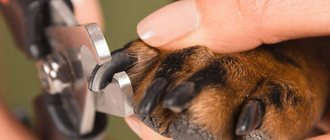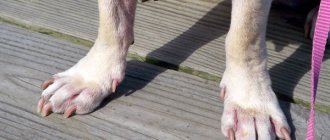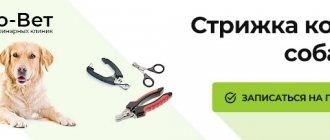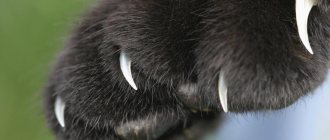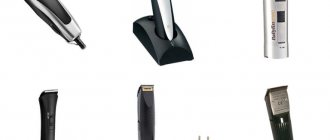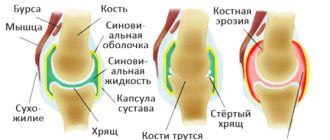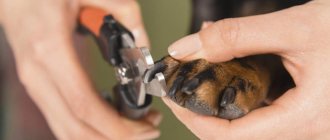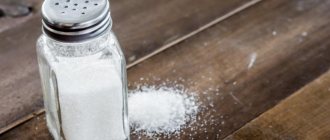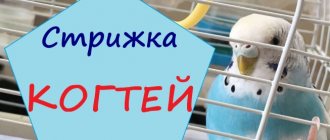Inexperienced owners sometimes do not know how to trim a dog’s nails, considering this task to be very difficult. But a haircut is necessary to ensure the health of a pet of any breed and size. The exception is working dogs, which run a lot on hard surfaces and their nails wear down naturally. A signal that it’s time to trim your pet’s claws will be a characteristic clicking sound when walking on a flat surface (smooth floor, tile, laminate).
Why should a dog have its nails trimmed?
It turns out that dogs need to have their nails trimmed regularly. You can do this at home yourself or visit a veterinarian for this purpose. To avoid problems with nail trimming in the future, you should accustom your dog to this procedure while still a puppy.
If you don't do this, then:
- over time, the pet may develop a curvature of the spine due to pain in the paws and changes in gait;
- long claws tend to be undermined by sudden movements and, as a result, the animal experiences blood poisoning from an infection that gets into the wound;
- a dog with overgrown claws injures its owners (especially children), as well as itself when it itches;
- claws damage carpeting and furniture in the house.
Many dogs have so-called dewclaws on their paws. If they were not removed during puppyhood, then if they remain, they can cause inconvenience to the animal. Since they are located high on the paw, the claws do not have the ability to grind down when walking or running. If they are not trimmed in time, they cause discomfort to the dog, growing into the skin and injuring it or regularly being undermined during active games. Therefore, every owner who cares about the health of their pet should know how to trim their dog’s nails.
Why trim the claw
If your pet's nail plate is not wearing down quickly enough, you need to help him. This is not a matter of aesthetics, but above all of health, because too long nails can affect the comfort of your dog's life, preventing him from walking normally. Neglecting this procedure may have the following consequences:
- pain when walking
- posture and gait disorders
- joint degeneration
- paw hypersensitivity
- finger bone injury
- purulent-inflammatory conditions
- imbalance
- lameness.
How often should a dog's nails be trimmed?
Regardless of the time of year, the growth rate of claws is constant. But in winter, when the ground is covered with snow, they do not have the opportunity to wear off on the asphalt as in summer. Therefore, in winter they need to be given a little more attention. On average, a dog's nails are trimmed once a month or a little more often. If this time is increased, then the vessel located at the base of each claw (pulp) will grow in length, and then it will simply be impossible for the dog to trim the claw without injuring the blood vessel.
Tools
The main tool is a nail clipper or “trimmer”. There are several types of nail clippers available at the pet market:
- scissors
– in the form of regular scissors or pruning shears, suitable for small and medium-sized breeds with thinner and more flexible claws; - guillotine
- comes in different sizes, suitable mainly for large breeds with hard and thick claws.
You need to choose a special tool based on the quality of sharpening and the reliability of the handles, which should be comfortable, preferably metal and rubberized. The use of human manicure tools is strongly discouraged, as they are not rigid enough. It is acceptable to use nail clippers to trim soft nails on puppies.
Subsequent treatment of the claws includes grinding, which is carried out with a nail file. It should be noted that there are electric scratching posts that allow you to safely and gently care for your dog’s nails. Using such devices eliminates the risk of damaging a blood vessel, but the procedure takes longer than cutting with nail clippers, and the noise from the operating device frightens some dogs.
In case of damage to living tissue, you need to have a hemostatic agent on hand.
Regardless of whether the dog is trained to trim its nails or not, it should be praised for good behavior during and after the procedure. Edible treats are ideal as rewards.
How to properly trim a dog's nails?
To carry out the procedure correctly, you should cast aside all doubts and not worry that the dog will be hurt. It's just like cutting your own nails. The main thing is to know how to cut them correctly, and for this you should examine the animal’s claws from the inside, especially if they are black claws in which it is impossible to see a blood vessel. Having discovered it, you should visually mark a distance of 2-3 mm, and then the success of the enterprise is guaranteed.
Actions must be performed in the following sequence:
- Before the procedure, you should wash your dog's paws clean.
- Choose a comfortable, well-lit place.
- To treat the front paws, sit the dog between the legs and take its paw in your hands.
- Lightly pressing on the pad, force each claw alternately to move out of the bed as much as possible in order to visualize the pulp, which cannot be damaged.
- Using nippers, quickly bite off the extra claw.
- If necessary, file the edges of the claw with a coarse abrasive file.
- Such actions are carried out alternately with all paws.
- It is more convenient to work with the hind legs if the dog lies on its side, and the owner kneels next to it or places it in front of him on a table or sofa.
- If trouble happens and the vessel is damaged, you should stop the bleeding with hydrogen peroxide and cauterize the injured area with iodine.
- At the same time as trimming the nails, it is recommended to remove the hair between the toes.
How to Trim Nails Without Stress
Most dogs find nail trimming intimidating and don't like to have their paw pads touched. In order not to cause stress for both you and your pet, you must first get used to carrying out such a procedure yourself and accustom your dog to it.
Start by gently touching a part of the paw that is not a problem for the dog, such as the forearm or wrist. Encouraging the dog, move your hand lower and lower, to the fingers and nails. Be sure to reward him if he allows it and remains calm.
You can use the “give a paw” command if the dog is already well accustomed to it.
The next step is to get accustomed to the tools you will use. Let the dog see and smell them. If you use a power tool, be sure to familiarize your dog with the sound of the device. An unknown sound can frighten him and he will reflexively jerk his paw.
Try running it dry a few times before starting the trimming procedure. Try to remain calm and be sure to praise and reward your dog with a treat if he has learned to remain completely calm in this situation. If he is still very scared, limit trimming to one nail per day.
How to trim a puppy's nails?
While the puppy is still small, it is quite possible to carry out manipulations with the claws at home, without resorting to the help of professionals. You should try to consolidate in a young dog the most pleasant emotions associated with trimming claws:
- Before the procedure, the baby needs to be given a good walk to reduce his physical activity.
- After washing his paws, you should put him on your lap and play with him a little to calm him down.
- The puppy needs to familiarize himself with the tool - the nail clipper - in advance, so as not to be afraid of its smell and the sounds it makes. It is recommended to keep all the tools for caring for the animal within sight and then, once he gets used to it, he will not react violently when he sees them.
- Before grooming, you need to stock up on treats for the puppy so that the procedure turns into an expected reward for him, and not torture.
- As a rule, the puppy’s claws are still soft and transparent, so there are no problems with detecting the pulp.
- Place the edge of the claw in the hole of the claw cutter and bite it off.
- Then we process the uneven edge of the claw with a file.
First aid
Unfortunately, no one is immune from injury, especially novice dog lovers. The hand trembles, the dog jerks sharply, or the length of the cut is incorrectly calculated and your pet will need help. That is why the materials necessary to provide it must also be prepared in advance and be at hand. This could be a special styptic powder, regular cornstarch or a simple bar of soap, hydrogen peroxide or chlorhexidine to disinfect the wound, bandages or napkins.
If your dog bleeds after trimming its nails, do not let your pet break free and run away from you. Try to calm him down, stroke him, pat him on the chest (this is the dog’s pleasure center). At the same time, begin to very carefully sprinkle the wound with powder or rub it with a cotton swab until the bleeding stops. If you use starch, sprinkle it on the wound, as rubbing can aggravate the situation and cause even more harm.
For minor damage, you can simply disinfect the wound with peroxide or chlorhexidine. You can also use a hemostatic pencil, which is pressed against the affected area of the claw for a few seconds and forms a dense clot that prevents further bleeding.
While providing first aid, offer the dog something tasty, try to distract him from what is happening as much as possible so that negative emotions do not become attached to the process of trimming his nails. Try to keep the dog calm for 15-20 minutes and not run, so as not to provoke re-bleeding.
If your pet reacts aggressively to an attempt to examine a wounded paw, the bleeding is excessive, or the dog continues to bleed 15 minutes after trimming its nails, contact your veterinarian immediately
If you are not sure that you can handle the procedure on your own or have not fully understood how to properly trim a dog’s nails with a nail clipper, you should entrust the procedure to a doctor or a professional in a grooming salon. As a last resort, ask for help from your household or those whom your pet knows well and is not afraid of. You can also consult with your veterinarian about taking sedatives for your dog before hygiene procedures. And remember, the calmer and more confident you are in your actions, the calmer and more trusting your pet will be.
Choosing a nail clipper for cutting a dog's nails
It is not advisable for even a small puppy to trim his nails with ordinary scissors. An animal's claws are much stronger and scissors will only separate them. When purchasing a dog, you need to immediately take care of equipment for it, if you do not plan to regularly visit the grooming salon. A nail clipper for cats is not suitable for the same reason – the different hardness of animal claws.
Nail clippers for dogs have the same function, but they look very different and their operating principles are also different.
Exist:
- wire cutters;
- guillotines;
- pruners;
- infrared cutters with cut boundary detection;
- electric sanding files.
Regardless of the nail trimming method you choose, you should rely on the size of the dog. For baby Pomeranians and Chihuahuas, a small tool is required, and the larger the dog, the larger the nail clipper should be purchased. It is important that it fits comfortably in your hand and has rubberized non-slip handles. Knowing how to trim a dog's nails can provide it with freedom of movement and a cheerful mood for many years to come.
Tools
To properly trim a dog’s nails, you need to prepare the necessary tools and medications in advance. The set should consist of the following elements:
- Claw clippers. Ordinary scissors cannot be used; they can injure the nail plate. You should take care in advance of a special tool that is sold in pet stores. There are two types of nail clippers: the first resemble wire cutters with sharp blades, and the second look like guillotines with holes where the claw to be trimmed is inserted. For large breed dogs with hard nail plates, it is better to purchase nail clippers in the form of nippers; in all other cases, you can use any device at your discretion.
- Nail file.
- Hemostatic agents - baby powder or flour.
- Antiseptic – iodine, peroxide, potassium permanganate.
- Cotton pads for treating wounds.
The owner needs to prepare the dog’s favorite treat in advance. It will help distract the animal’s attention during the procedure and will be a pleasant reward upon completion of the process.
An important nuance is to be patient and choose the best time for a haircut. It is optimal if the dog has just eaten or returned home after a long walk. In this state, he will not be able to actively resist your actions.
Test on how to trim a dog's nails yourself
We suggest you take a short test to see if you know how to trim a dog's nails correctly.
#1 Everyone knows that dogs need their nails trimmed and filed down. What are the people who do this professionally called?
People who trim dogs' nails are called groomers.
#2 What is the correct name for the tool used to trim dogs' nails?
The tool used to trim dogs' nails is called a nail clipper.
#3 How often should indoor dogs have their nails trimmed?
Dogs that live at home need to have their nails trimmed once or twice a month.
#4 Where is the best place to trim nails at home?
It is best to trim nails at home - in a convenient place with good lighting.
#5 There are many types of nail clippers for dogs. Which of the following items is not related to this instrument?
tweezers - not related to types of nail clippers for dogs
#6 What should the handles of a good nail clipper be like?
A good nail clipper should have rubberized handles.
#7 What should a dog owner do before starting nail trimming?
Before starting the nail trimming procedure, the dog owner must calm down.
#8 Does the choice of grooming tool depend on the breed and size of the dog?
Yes, one type of tool is suitable for large breeds of dogs; for small breeds they choose another.
#9 What should you do with tools before and after trimming nails?
Before and after trimming nails, tools need to be sterilized.
#10 What should you pay close attention to during the nail trimming procedure to avoid injuring your dog?
to avoid touching the pulp (tissue with blood vessels);
#11 Which of the following must be on hand for an owner who is going to trim their pet’s nails?
styptic powder, iodine or hydrogen peroxide
#12 To help puppies develop pleasant associations during nail trimming, keep on hand:
To help puppies develop pleasant associations during the nail trimming procedure, keep your pet’s favorite treat on hand.
Check result
What you need to know for this
The best decision would be to entrust your pet to a veterinarian or professional groomer. Nails need to be trimmed at least once every three to four weeks. It all depends on the individual characteristics and conditions of keeping the dog. Unfortunately, not everyone and not always have such an opportunity. But, you can learn to do it yourself. The procedure, although it requires preparation and some knowledge, is actually simple. Ask your veterinarian to explain to you all the features of cutting and show you exactly how it is done. Once or twice will be enough. You will learn how to trim nails correctly and understand how to behave with your dog during the procedure.
If you decide not to resort to outside help even for the first time, carefully prepare for the procedure. First, you need to learn how claws are structured, how they grow, and how to properly trim a dog’s claws with a special nail clipper.
Claws are not just a keratinized part of the body. Unlike human nails, animal claws have a large blood vessel. Its peculiarity is that it grows along with the claw. And the longer they are left uncut, the longer and closer to the end of the claw it becomes. When the claws are regularly shortened, the blood vessel also contracts. You can clearly see it in cats. With dogs it’s a little more complicated - in light-colored claws you can see a dark red tube, in black claws it is completely invisible. You need to cut the claw 2-3 mm lower than where the vessel is visible, as it may turn out to be longer than it seems at first glance. Therefore, black claws will have to be cut very little at a time, no more than 1 mm at a time, constantly checking whether the claw has lightened and whether you have gotten close to the vessel.
How to accustom a dog to the procedure
You need to accustom your pet to trimming its nails from an early age. Over time, the dog will get used to the manipulations, will not be afraid of them, and it will take you a minimum of time. If the dog is not familiar with the procedure and does not understand what you want from it, it may become nervous, break out, and show aggression.
Preparation
Trimming your dog's nails at home should be taken very seriously. Improper actions can cause harm, both physical and mental.
A few days before you plan to do grooming, begin to establish tactile contact with your pet. Teach him not to be afraid of your touching his paws and pads. Several times a day, squat down next to your dog so that you are at approximately the same level with him. Stroke the paws, pick them up during play, touch the pads and claws. The dog should not feel threatened by such touches.
Choose a moment when the animal is calm, well-fed and satisfied. Before you start trimming the nails, you need to satisfy all the needs of the pet - take it for a walk. A dog that is tired after a walk will react more calmly. This is especially true for active breeds and puppies. Try to provide a comfortable environment for the dog, pet it, talk, calm it down, and only then proceed directly to the procedure.
Trimming dog's nails at home
You can start with one or two claws a day. Prepare in advance and be sure to disinfect a special tool for cutting dog nails so that it is ready to hand. It’s good if your pet has the opportunity to get to know him in advance, sniff him and examine him. Only after this can you proceed directly to cutting:
- When interacting with your dog, take its paw in your hand, hold it firmly, but not too tightly - you should not hurt the dog or make it feel threatened by violent action on your part. Use your thumb and forefinger to secure the dog's finger on which you are going to cut the claw, and apply light pressure.
- Try not to touch the area between your dog's toes. She might not like it.
- Disinfect nails to avoid infection in case of unexpected complications during cutting.
- Determine the approximate length of the claw that needs to be cut. Do not hurry. It's better to cut a little less than you need. This way you will be absolutely sure that you will not damage the blood vessel. Cut off the curved part of the claw first. An almost correct, lighter oval shape of the cut will mean that the living part of the claw is located further and it is no longer possible to cut.
- Take the tool and with one precise, short press, cut the required length.
- The claw must be cut at an angle of 45° from top to bottom. To avoid delamination and creases on the claws, always cut perpendicular to the growth line, trying to avoid sharp corners.
- Process the cut first with a large file and, if necessary, with a fine sanding file.
- If the dog remains calm, you can continue the procedure. If your pet gets nervous, gets scared, or starts to struggle, let him go and try to calm him down. Talk to him kindly and offer him some treat. Try to continue.
- It is more convenient to trim the nails on the hind legs when the dog is lying down. Place her on a covered table or sofa and have someone hold her.
Why should nail trimming be regular?
Long claws are harmful to health.
The inside of a dog's nail, called the pulp, consists of a large blood vessel and a huge number of nerve endings.
This blood vessel tends to grow as the horny cover of the claw grows. The longer the claw, the longer the blood vessel located in it will be. If the owner starts this process, the claws can reach such a length that each haircut carries the risk of injury to the sensitive pulp. It is possible to correct this situation, but this process will take a lot of time.
How to trim neglected claws? Very small pieces, a little bit at a time . With each new trim, the pulp will recede into the claw. After some time, trimming nails will no longer be a problem.
What is the difference between cutting clear and dark nails?
Colorless claws are easier to trim.
Most often, dog claws are light, white or transparent.
Trimming them is much easier and safer than pigmented or completely black claws, since the light horny cover allows you to easily determine the boundary of the living part of the claw (it looks like a pink tube) and avoid injury. For light-colored claws, only the part that is devoid of blood vessels is trimmed. Trimming black claws will have to be done at random, so special care is required here. You need to cut off the tip of the claw in small layers until a black dot appears in the center of its section. You cannot cut beyond this border.
Tools and materials for trimming nails
When planning to trim your dog's nails, you need to purchase:
- Special scissors (they are also called trimmers or nail clippers), which are sold in specialized pet stores. Nail clippers come in two types: in the form of scissors with crescent-shaped blades and in the form of nippers (guillotines) with a blade resembling a large needle with an enlarged eye. Scissors are convenient for trimming the strong nails of large dogs, and guillotines are useful for caring for small breed dogs. The main criteria for choosing quality nail clippers should be the reliability of the handles and the sharpness of the sharpening.
Claw clipper tools.
Dog claws cannot be trimmed with ordinary scissors : lacking a bend corresponding to the natural curvature of the claws, they contribute to the formation of chips and their additional trauma. Simple scissors do not cut, but split dog claws. - A special file for dog nails. An ordinary file for human manicure will not work, because the durable claws of pets will only succumb to the coarse abrasive of a specialized tool.
- Disinfectants and hemostatic agents: 3% hydrogen peroxide, a special hemostatic pencil, potassium permanganate or iodine, as well as baby powder, talc or corn starch. All these means are necessary to provide first aid to a pet who has received a minor injury during the nail trimming procedure.
- Comfortable scissors with rounded tips. This tool will help trim excess hair between your fingertips. This procedure, performed at least once a month, not only facilitates access to each claw, but also has a preventive value, relieving the dog’s limb from the threat of accumulation of dirt and painful microflora hiding in it. If you do not use shoes for your dog, then in winter snow can freeze on the fur between the pads, which is why a small dog can slip and even scratch its paws until they bleed. The fur between the pads can also form into dense mats, which will make the dog uncomfortable while walking. Hair trimming is the best way to prevent fungal infections that occur in conditions of high humidity (in winter, the dog’s skin can get wet).
Recommendations if your dog is bleeding
If you accidentally cut off part of the pulp, the animal twitched and was injured, or worse, the claw was completely torn out, then act quickly. Do not panic yourself, try to calm the howling dog - give it the most delicious treat .
After this, immediately take out dry potassium permanganate or talc, put it on gauze and apply to the wound for a minute to stop the bleeding. Afterwards, apply ice wrapped in cotton cloth for a short time. If there are severe tears, fill the wound with novocaine.
Do not let the animal run and hide - immediately disinfect the wound!
If the wound is serious and the animal is crying, then immediately go to the veterinary clinic or call a doctor at home.
How to properly hold your dog while trimming its nails?
We hold the dog gently but securely.
The position of the dog at the time of trimming its nails is determined by its size and breed.
When trimming the claws of a small dog, the owner most often sits it on his lap and, clasping its body with one hand, performs all the necessary manipulations with the other. A large breed dog is placed on a small elevation covered with a rug (the rug prevents paws from slipping). If the animal is very anxious about the upcoming procedure, the owner should sit behind him and begin trimming the nails on the front legs, holding the dog by the back and neck.
What the owner should do before trimming claws
- When planning a nail trimming procedure, the dog owner should make sure that the dog is in a good mood and not stressed. If the dog has never had its nails trimmed before, on the day of the scheduled procedure you should sit next to it several times and, clicking the nail clipper, talk to it affectionately. The animal must understand that this tool does not pose any danger.
- During nail trimming and after completion of the procedure, it is necessary to reward the animal with some special treat used exclusively for this moment. The dog must develop a positive conditioned reflex : it will very quickly learn that the procedure of cutting nails is not only safe, but also rewarding.
- When planning to trim nails, you need to prepare hemostatic or disinfectants, corn starch or talc. Even experienced dog owners occasionally injure their dogs by trimming their nails too short. There is no need to make a tragedy out of this.
